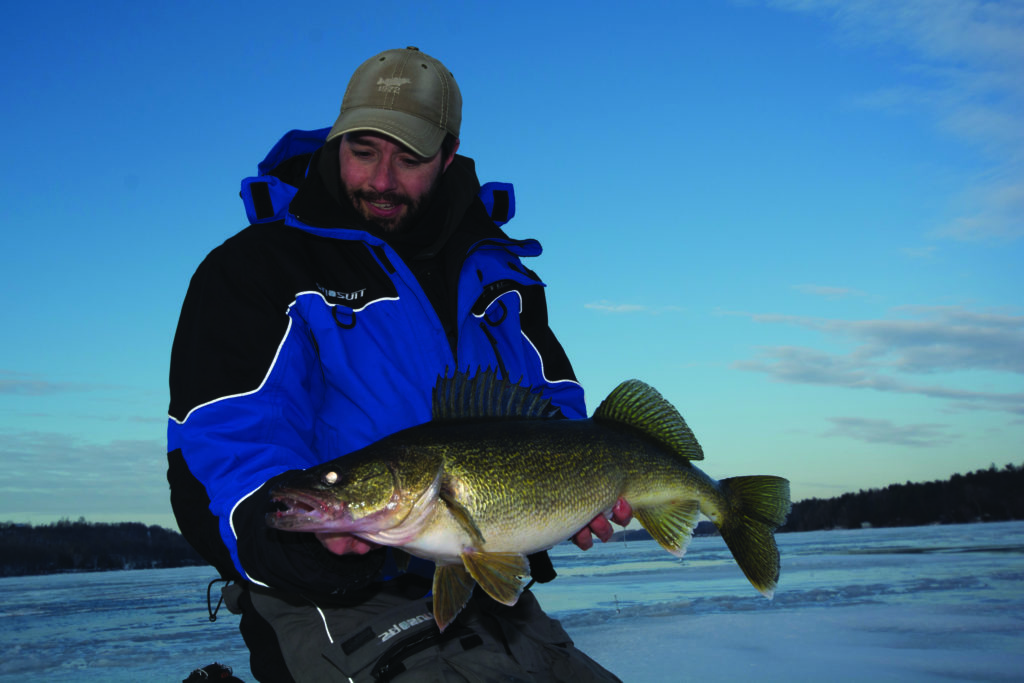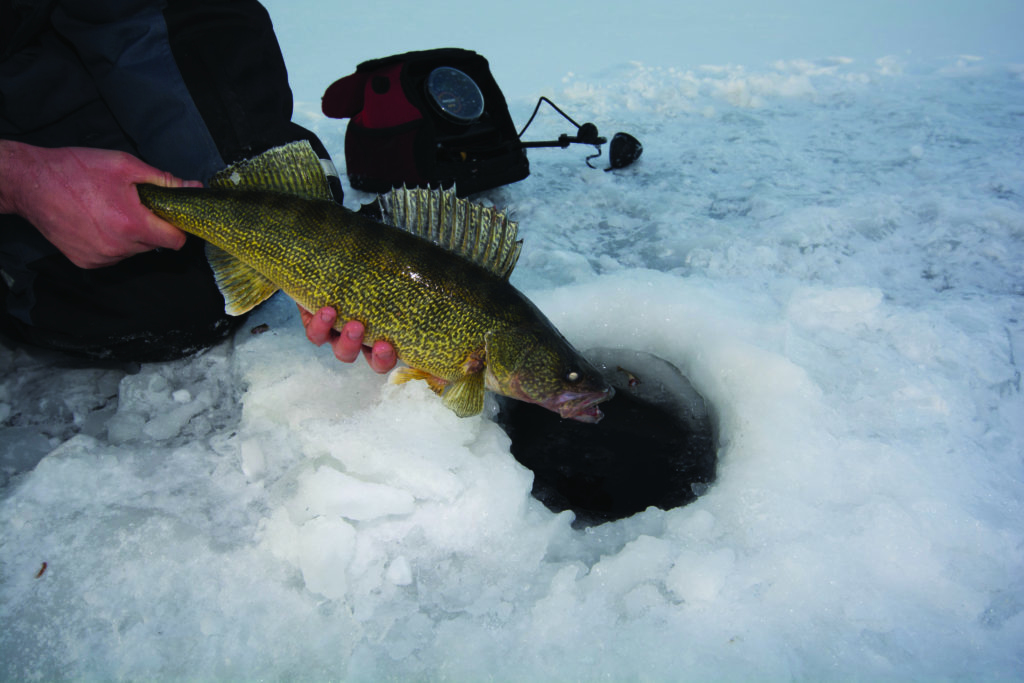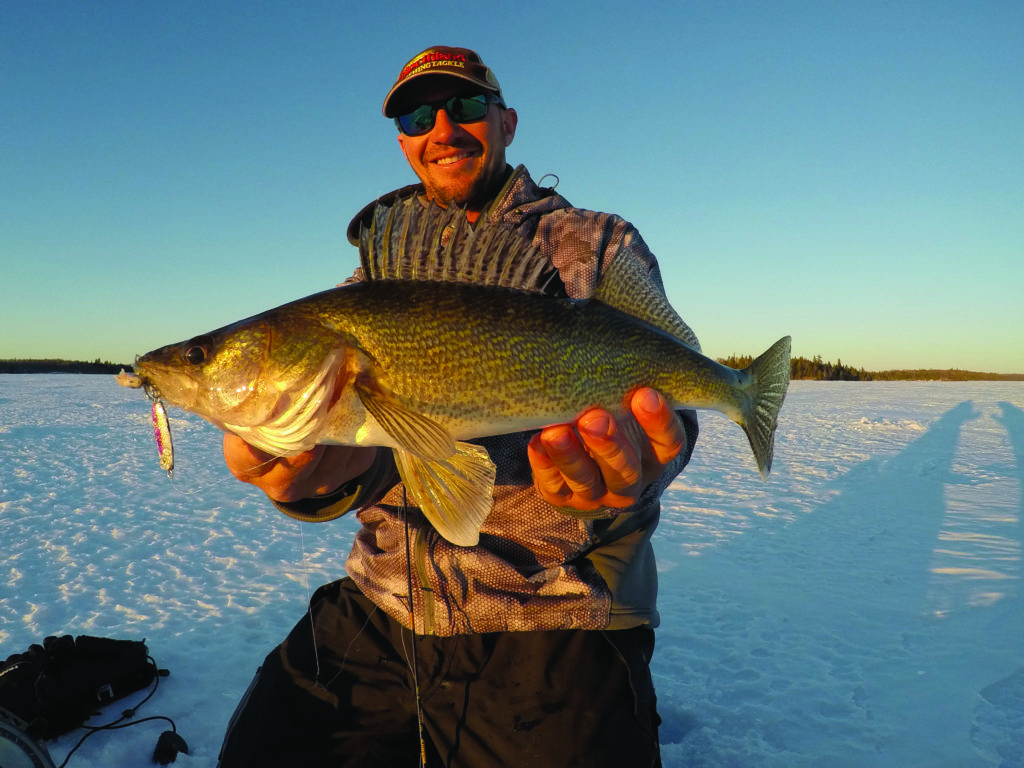In the hard-water game, every hole drilled is the equivalent to an open-water cast. As such, ice anglers must be strategic where they drill. One easy way to catch more winter walleyes is drilling holes over key contour changes. Walleyes are a creature of edges and they will relate to specific structural elements, like a rocky spine — key things to look for the next time that you put boots on ice.
Features on Flats
Deep to mid-depth flats are common wintertime hangouts for walleyes. When fishing these dishpan areas it’s best to concentrate on any kind of depth variation, bottom transition or anything else that’s different. These anomalies are where walleyes like to loiter.
I’ve seen this play out many times. Several trips with friends to the Bay of Quinte come to mind. It’s amazing how a few individuals can have a hot hole, while others 30 feet away can’t mark a fish. More often than not, the reason that specific holes are productive is because they are over a contour variation, such as a rocky ridge or a trough. The lesson here is if you’re not marking fish when jigging flats, keep moving until you do.
Fishing the drop-off of a flat is another good strategy. What’s even better, though, is concentrating on where there’s an inside or outside bend along this contour. If there’s any flow, these turns create current breaks for walleyes (be mindful as current variations also influence ice thickness and safety). Even without flow, inside and outside bends attract ‘eyes better than uniform ledges, and these zones are worth exploring on flats.
While digital lake maps are helpful for finding bends and other distinct elements on flats, depth variations of a few feet aren’t typically captured in this data. Locating subtle features comes from taking depth readings with a portable fish finder. Using an underwater camera can also reveal unique structural elements attractive to walleyes.

Jeff “Gussy” Gustafson, who guides on Lake of the Woods and other Sunset Country waterbodies, regularly fishes large flats for walleyes. He finds specific sites concentrate fish.
“Over time as I fish these spots I always save the best places with a waypoint on the GPS on my snowmobile, and often these waypoints have something on the bottom that attracts the fish — maybe a brush pile, rock pile, clump of grass, sand spot, just something different,” Gustafson said. “Be prepared to keep moving because these fish float around on these areas.”
Whether he is fishing a deep flat in midwinter or concentrating on the 6- to 12-foot range at late ice, Gustafson’s go-to walleye bait is a Northland Buck-Shot Rattle Spoon tipped with a minnow head. He likes to fish a heavy spoon, such as a 3/8-ounce version in shallow water.
“It’s noisier and I like crashing it into the mud every so often to help attract fish to come in for a closer look,” he said.
The Power of Pinch Points
Pat Kalmerton, a year-round Wisconsin guide, says pinch points are a reliable winter walleye location. This is an example of a contour variation on a large scale. Kalmerton describes these zones as a section on a lake where two shoreline points push out into deep water, creating a narrow section between them with a larger upper and lower lake on opposite sides of the pinch.
“They kind of look like a figure-eight or a peanut, with the two shores coming close together,” Kalmerton said. “Fish are going to swim back and forth through there and it’s the perfect place for me to run my tip-up trapline.”
Kalmerton is a tip-up fanatic and spreads out these devices at different depths to determine where walleyes are situated. He uses several lines, as regulations allow for the party he’s guiding, to cover water. During our conversation he repeated that every lake is different and even the same lake can fish different from one day to the next. Staggering tip-ups from shallow to deep along a break associated with a pinch point helps him determine the walleyes’ preferred depth that day and any contour preferences, such as bottom transition, rock piles, etc.

Kalmerton uses Clam’s Blue Ice tip-ups with 6-pound Frost fluorocarbon line with a #14 or #16 treble hook and weight. Most times he hooks a minnow behind the dorsal. If he finds walleyes are bottom oriented, he will tail hook some minnows in his spread. Tail-hooked minnows sit nose-down in the water, giving off a natural, bottom-feeding appearance.
Once his “tip-up trapline” is set, Kalmerton moves around with a rod and jigs the area. As flags fly, he focuses on specific spots where ‘eyes are caught on the setlines. He jigs large, flashy spoons, like Clam’s Leech Flutter Spoon, to attract fish to his trapline and appeal to active fish cruising the contour.
“I’m not jigging bottom,” Kalmerton said. “I’m fishing the midwater column and I’m ripping it up to get it fluttering, then letting it free-fall.”
Kalmerton will also work vertical jigging minnows like the Rapala Jigging Rap, and rattling and nonrattling spoons. He finds different lure actions, profiles and colors can be hot on specific water bodies.
Hump Particulars
It’s no secret that walleyes love midlake humps in winter. But, it’s rare for fish to be distributed equally all over a structure. Instead, they position on key spots. On one lake that I fish, a rock slide off of a hump is what concentrates walleyes. Fish are deep during the day, then swim up the rockslide to get to the top of the hump to gorge on yellow perch as the sun sets. A sandbar extending out from a bay or shallow food shelf is another example. Gustafson has observed similar deep-to-shallow walleye behavior in Sunset Country.

“We fish walleyes a lot in the evenings and it’s interesting to watch these fish move from 35 to 40 feet during the day, off the sides of humps and points, up on top of these structures to feed in the evening,” Gustafson said. “You can start out deep and move up with the fish, with the peak bite happening just before dark on the tops.”
I had the good fortune of joining Gussy years ago on Lake of the Woods, along with fellow guide Dave Bennett. During the day, finding the fingers extending off of humps was a key strategy to catching walleyes. Another was locating portions of a hump with a gradual drop-off, like stairs. These “steps” attracted ‘eyes better than a steep, abrupt drop. Then it was a matter of locating the right depth and being prepared to move shallower as evening set in.
Cover Considerations
No matter the structure, anglers should always study their sonar from one hole to another, looking for any changes to bottom hardness readings. Walleyes frequently relate to soft-to-hard bottom transitions and finding them will put you on fish. I’ve alluded to some of these features above. For example, rock piles or boulders on a sand bar or mud flat are classic spot-on-spot walleye scenarios.
But, bottom changes don’t always need to be quite so contrasting. Some of Kalmerton’s prime walleye spots are where gravel turns into larger rocks. Then, in other spots he says it’s about finding harder clay.
Kalmerton also likes zones where weed lines come down a drop-off. There, the addition of cover on a high-percentage structural element will draw in fish. Gustafson also notes grass patches on flats appeal to walleyes. The cover is attractive to baitfish, yellow perch and other prey for walleyes. We can also add brush piles and other sunken items, like boats or cribs, to the list of anomalies that walleyes prefer on large structures.
Be on the lookout for bottom variances when ice fishing for ‘eyes. What’s different is often where the fish are located, and finding those spot-on-the-spot elements will improve your success on the hardwater.
— Tim Allard of Ottawa, Ontario, is a hard-water expert and author-photographer of the multi-award winning book, “Ice Fishing: The Ultimate Guide.”


